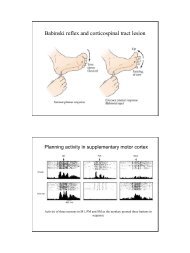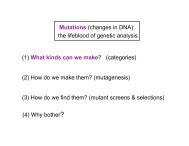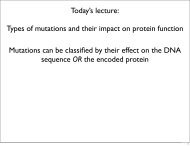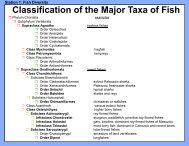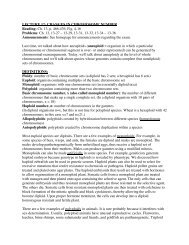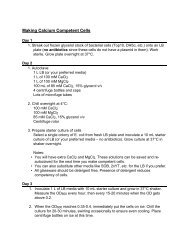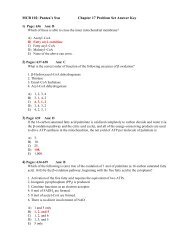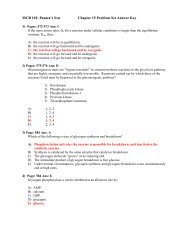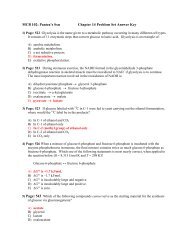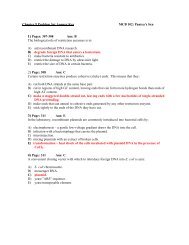Drosophila FLP/FRT Screens and a model for cancer genetics ...
Drosophila FLP/FRT Screens and a model for cancer genetics ...
Drosophila FLP/FRT Screens and a model for cancer genetics ...
You also want an ePaper? Increase the reach of your titles
YUMPU automatically turns print PDFs into web optimized ePapers that Google loves.
<strong>Drosophila</strong> <strong>FLP</strong>/<strong>FRT</strong> <strong>Screens</strong> <strong>and</strong> a <strong>model</strong> <strong>for</strong> <strong>cancer</strong> <strong>genetics</strong><br />
Reading: Chapter 18, pp637-639<br />
Problem set G<br />
So far we have mentioned how hypomorphic mutations (vulval<br />
development mutants in C. elegans) <strong>and</strong> haploinsufficiency in sensitized<br />
genetic backgrounds (temperature-sensitive sev mutant background) can<br />
identify essential genes involved in development. In these cases null or<br />
amorphic alleles of these genes result in an early lethality that precludes<br />
us from underst<strong>and</strong>ing their roles in signaling. Another strategy is to<br />
make clones of cells that are mutant <strong>for</strong> an essential gene in the tissue that<br />
you are studying. As we saw in the last lecture on mosaic analysis, the<br />
production of clones can be stimulated with X-rays. Today, we will<br />
discuss recent advances that use genes <strong>and</strong> sites that are involved in<br />
recombination in yeast to stimulate mitotic recombination in <strong>Drosophila</strong>.<br />
We will then discuss how these tolls are used to screen specific<br />
chromosomal arms <strong>for</strong> mutations that disrupt targeting of the<br />
photoreceptor cells to the brain.<br />
The yeast <strong>FLP</strong> recombinase <strong>and</strong> <strong>FRT</strong> sites<br />
Where <strong>and</strong> when mosaic clones are produced during development can be<br />
controlled by using tissue specific enhancers to drive recombinase<br />
enzymes that recognize specific sites engineered into the genome. The<br />
yeast 2 um plasmid encodes an enzyme known as the <strong>FLP</strong> recombinase<br />
that recognizes two <strong>FRT</strong> sites <strong>and</strong> catalyzes reciprocal exchange between<br />
these sites. This recombination occurs during replication <strong>and</strong> results in an<br />
internal flipping the orientation of the regions flanking the two sites. This<br />
flipping results in an addition round of replication <strong>and</strong> is thought to be<br />
important to amplification of the 2 um plasmid, which exists in high copy<br />
number in yeast.<br />
The <strong>FLP</strong> recombinase <strong>and</strong> <strong>FRT</strong> sites can also be used to stimulate<br />
reciprocal exchange in flies. The <strong>FRT</strong> sites, which are recognized <strong>and</strong><br />
cleaved by <strong>FLP</strong> recombinase to initiate crossing over between the two sites,<br />
have been placed near the centromere on all chromosomal arms using P<br />
element transposition. To stimulate exchange, <strong>FLP</strong> recombinase can be<br />
expressed in any tissue to stimulate mitotic recombination.<br />
We will consider a specific example of the use of <strong>FLP</strong> recombinase<br />
<strong>and</strong> <strong>FRT</strong> sites to screen <strong>for</strong> mutations that disrupt the pattern of<br />
photoreceptor axon targeting in the fly brain.<br />
Tumor suppressor genes<br />
Tumor suppressor genes usually encode proteins that inhibit cell<br />
proliferation. Although more rare, Tumor suppressor genes can also
encode proteins that inhibit apoptosis. Mutated <strong>for</strong>ms of these genes can<br />
be inherited dominantly, but a second event must occur be<strong>for</strong>e the mutant<br />
contributes to <strong>cancer</strong>. The wild-type copy of the gene must be lost, <strong>and</strong> this<br />
can occur by spontaneous mutation, chromosomal loss (not shown above)<br />
or mitotic recombination. This “loss of heterozygosity” leads to a cell that<br />
is no longer inhibited from proliferating or a surviving cell that is<br />
pre<strong>cancer</strong>ous <strong>and</strong> normally fated to die. The diagram showing how both<br />
spontaneous <strong>and</strong> inherited <strong>for</strong>ms of retinoblastoma occur when<br />
mutations lead to a mutant Rb locus. In inherited <strong>for</strong>ms of Rb, the one<br />
mutant allele is inherited, but the wild-type allele must be lost be<strong>for</strong>e
etinoblastoma tumor is <strong>for</strong>med. This trait is inherited in a dominant<br />
fashion, but the at the level of the cell the <strong>cancer</strong> only <strong>for</strong>ms when both<br />
copies are mutant.<br />
<strong>FLP</strong>/<strong>FRT</strong> screens <strong>for</strong> tumor suppressor genes in <strong>Drosophila</strong><br />
Iswar Hariharan <strong>and</strong> his coworkers have developed screens to identify<br />
tumor suppressor genes in the fly. The strategy is to generate mutations in<br />
a single chromosome <strong>and</strong> then to stimulate recombination to generate<br />
clones that are homozygous <strong>for</strong> the mutation. If the mutation is in a tumor<br />
suppressor gene, these cells should proliferate at the expense of cells<br />
containing the wild-type gene.<br />
Several tools are used in these screens. First, the chromosome arm<br />
screened contains an <strong>FRT</strong> site near the centromere, inserted into the<br />
chromosome using P element mediated trans<strong>for</strong>mation. Chromosome<br />
arms are screened one at a time, <strong>and</strong> the screens will only identify<br />
mutations that are distal to the <strong>FRT</strong> site. These sites are where<br />
homologous recombination occurs <strong>and</strong> are necessary to generate clones<br />
that are homozygous <strong>for</strong> the mutation in the tumor suppressor gene.<br />
Second, <strong>FLP</strong> recombinase is expressed in a particular tissue using a<br />
specific promoter. This drives recombination in that tissue alone <strong>and</strong><br />
avoids the possible lethality associated with the loss gene function in<br />
other tissues. In this case the eyeless promoter is used, which drives<br />
expression of the recombinase only in the developing eye. The eyeless-<strong>FLP</strong><br />
transgene is inserted into a chromosome using P-element mediated<br />
trans<strong>for</strong>mation. Finally, a cell autonomous marker is used to identify the<br />
clones that are homozygous <strong>for</strong> the mutation. These are usually a P<br />
element-transposed wild-type white gene. In a white mutant background,<br />
the P[w+] is placed on the chromosome not containing the mutation. In<br />
this way, white clones that lack the P[w+] transgene will be homozygous<br />
<strong>for</strong> the mutation.<br />
The rationale <strong>for</strong> the screen is described in the Figure below. The<br />
strain is homozygous mutant <strong>for</strong> white but also has a transgene containing<br />
a copy of the wild-type white gene (P[w + ]) on the autosome that contains<br />
the <strong>FRT</strong> sites. The ey<strong>FLP</strong> is on the X chromosome <strong>and</strong> that X is also<br />
marked by the yellow mutation. It’s here to mark the X containing ey<strong>FLP</strong>,<br />
but don’t worry about it here. Let’s consider the situation now where the<br />
autosome lacking P[w + ] contains a mutation in a tumor suppressor gene<br />
(labeled m). Be<strong>for</strong>e recombination the cells are heterozygous <strong>for</strong> m <strong>and</strong><br />
hence normal (remember that tumor suppressor genes are recessive at the<br />
level of the cell—they must be homozygous to <strong>for</strong>m a tumor) <strong>and</strong><br />
heterozygous <strong>for</strong> P[w + ] <strong>and</strong> hence are red. In the developing eye, <strong>FLP</strong> is<br />
expressed <strong>and</strong> this stimulates mitotic recombination between the <strong>FRT</strong>
sites. Some of these recombination events will lead to cells that are<br />
homozygous <strong>for</strong> the m tumor suppressor mutation. These cells (on the left)<br />
will be white <strong>and</strong> continue to proliferate because of the mutation, whereas<br />
the cells that aren’t homozygous <strong>for</strong> the mutation will be red <strong>and</strong> won’t<br />
divide in an uncontrolled fashion.<br />
ey<strong>FLP</strong> w<br />
w<br />
<strong>FRT</strong> m<br />
<strong>FRT</strong> m<br />
ey<strong>FLP</strong> w<br />
w<br />
<strong>FRT</strong> m<br />
<strong>FRT</strong> P[w + ]<br />
This situation leads to the expansion of white cells in a mosaic eye.<br />
Below are mosaic fly eyes that don’t contain a tumor suppression (left) or<br />
have mutations in a tumor suppressor gene called sav (middle <strong>and</strong> right).<br />
The allele on the right is more severe than the allele in the middle so there<br />
are more white cells <strong>and</strong> the eye is de<strong>for</strong>med because too many cells are<br />
made.<br />
X<br />
ey<strong>FLP</strong> w y<br />
w<br />
<strong>FRT</strong> P[w + ]<br />
<strong>FRT</strong> P[w + ]
The last thing that we need to consider now is how the mutant<br />
screen was carried out, <strong>and</strong> that is illustrated in the two boxes below. First,<br />
males hemizygous <strong>for</strong> white <strong>and</strong> homozygous <strong>for</strong> <strong>FRT</strong> sites on an<br />
autosome that will be screened are mutagenized with EMS. These males<br />
are then crossed with females homozygous <strong>for</strong> white <strong>and</strong> heterozygous <strong>for</strong><br />
a balancer <strong>for</strong> the autosome being screened. (Remember that a balancer<br />
chromosome using has multiple inversions to inhibit the <strong>for</strong>mation of<br />
viable progeny with a recombinant chromosome, a recessive mutation,<br />
often a lethal <strong>and</strong> a dominant mutation—balancers are described on<br />
pp454-455 <strong>and</strong> pp817-818.) All of the progeny from this cross will have<br />
white eyes. Those of interest will contain a mutagenized chromosome<br />
containing the <strong>FRT</strong> site <strong>and</strong> the balancer chromosome, which can de<br />
identified by the presence of the phenotype caused by the dominant<br />
mutation on the balancer.<br />
EMS<br />
w<br />
<strong>FRT</strong><br />
<strong>FRT</strong><br />
or<br />
w<br />
w<br />
mm<br />
<strong>FRT</strong><br />
What needs to be done now is to generate animals with the mutagenized<br />
chromosome, that are also homozygous <strong>for</strong> the <strong>FRT</strong> sites <strong>and</strong> express <strong>FLP</strong><br />
in the eye. To do this, the F1 females are crossed with males that have the<br />
ey<strong>FLP</strong> trangene <strong>and</strong> that are homozygous <strong>for</strong> the FRP sites <strong>and</strong> P[w + ]. The<br />
female progeny from this cross that lack the dominant phenotype caused<br />
bythe balancer chromosome have ey<strong>FLP</strong> transgene, are homozygous <strong>for</strong><br />
the <strong>FRT</strong> sites <strong>and</strong> have the P[w+] on the nonmutagenized chromosome. If<br />
the mutagenized chromosome contains a mutation in a tumor suppressor<br />
gene, then these females should have expansion of white tissue in the eye.<br />
X<br />
w<br />
w<br />
Balancer<br />
Balancer<br />
ff<br />
Mutagenized chromosome
w<br />
w<br />
F2 progeny<br />
w/o balancer<br />
<strong>FRT</strong><br />
Balancer<br />
Mutagenized chromosome<br />
ey<strong>FLP</strong> w<br />
w<br />
Using this approach, Hariharan <strong>and</strong> his colleagues identified 23<br />
genes involved in the regulation of proliferation <strong>and</strong> apoptosis in the eye.<br />
These genes have homologs in humans, <strong>and</strong> tumors were screened to see<br />
of any of them were mutant <strong>for</strong> the homologs <strong>and</strong> some were suggesting<br />
that these genes are also tumor suppressors in humans.<br />
Problem set G<br />
1. Integrins are alpha/beta heterodimeric receptors that bind to molecules<br />
in the extracellular matrix. A primary role of integrins is in adhesion,<br />
ensuring that cells attach to the matrix, <strong>and</strong> cell biologists have identified<br />
several proteins that link the intracellular tail of the beta integrin to the<br />
actin cytoskeletin. During the development of the <strong>Drosophila</strong> wing, cells<br />
on the dorsal <strong>and</strong> ventral surfaces adhere to the matrix. Mutations in the<br />
beta integrin gene lethal(1)myospheroid lead to recessive lethality, but<br />
hypomorphic mutations lead to wing blisters where the portions of the<br />
dorsal <strong>and</strong> ventral surfaces separate. From what you know about<br />
integrins, propose a <strong>model</strong> <strong>for</strong> how integrins function in wing<br />
development.<br />
You screen <strong>for</strong> mutations that lead to wing blisters using <strong>FLP</strong>/<strong>FRT</strong><br />
induced recombination. Describe which genetic tools you will need to<br />
conduct the screen.<br />
f<br />
X<br />
ey<strong>FLP</strong> w y<br />
<strong>FRT</strong><br />
<strong>FRT</strong> P[w + ]<br />
<strong>FRT</strong> P[w + ]<br />
<strong>FRT</strong> P[w + ]<br />
m<br />
Mutagenized chromosome
The frequency wing blistering in the hypomorphic mutant of<br />
lethal(1)myospheroid is 5-10%. Although the mutations you isolated in your<br />
<strong>FLP</strong>/<strong>FRT</strong> screen are recessive, they are dominant enhancers of the<br />
hypomorpic lethal(1)myospheroid mutant. Why do you think that these<br />
mutations enhance the severity of the wing blistering phenotype? Do you<br />
think that they are loss-of-function mutations, <strong>and</strong> if so describe a genetic<br />
test that shows the enhancement is caused by a loss of function.<br />
2. In the <strong>Drosophila</strong> eye, the R7 photoreceptor cell is specified by signaling<br />
from R8. You isolate two mutations on chromosome 2 that are missing R7.<br />
You generate animals that mutant <strong>for</strong> white gene on the X chromosome.<br />
They are heterozygous <strong>for</strong> one chromosome that has one of the mutations<br />
<strong>and</strong> a homologous chromosome that has a wild-type white transgene<br />
integrated in a position that maps near where the mutation lies. These<br />
animals are irradiated during development <strong>and</strong> animals with eyes that<br />
have white patches are analyzed <strong>for</strong> the presence of mosaic ommatidia.<br />
Below are the results of mosaic ommatidia that have the R7 cell. Each<br />
number represents the number of cells that are mutant or wild type <strong>for</strong><br />
white (w). In the 59 ommatidia analyzed <strong>for</strong> mutant 1, <strong>for</strong> example, 40 of<br />
the R1 cells were wild type <strong>for</strong> white <strong>and</strong> 19 were mutant.<br />
Mutant 1<br />
Cell wild type <strong>for</strong> w mutant <strong>for</strong> w<br />
R1 40 19<br />
R2 33 26<br />
R3 32 27<br />
R4 36 23<br />
R5 36 23<br />
R6 47 12<br />
R7 59 0<br />
R8 31 28<br />
Mutant 2<br />
Cell wild type <strong>for</strong> w mutant <strong>for</strong> w<br />
R1 42 18<br />
R2 27 33<br />
R3 32 27<br />
R4 35 25<br />
R5 40 20<br />
R6 39 21<br />
R7 35 25<br />
R8 60 0
a) Why are the animals irradiated?<br />
b) From what you know about R7 specification propose in which cells the<br />
genes defined by these two mutations act <strong>and</strong> explain your reasoning. (10<br />
points)<br />
3. Ras can exist in two states. A GTP bound <strong>for</strong>m of Ras is active, <strong>and</strong> a<br />
GDP bound <strong>for</strong>m is inactive. GEFs stimulate the exchange GDP <strong>for</strong> GTP<br />
<strong>and</strong> thus promote an active Ras. GAPs stimulate the GTPase activity of<br />
Ras <strong>and</strong> thus promote the <strong>for</strong>mation of an inactive Ras. Activation of the<br />
Sev receptor by Boss stimulates the <strong>for</strong>mation of GTP Ras.<br />
In a screen <strong>for</strong> dominant suppressors of the R7 phenotype of the sev ts<br />
strain of flies raised at the nonpermissive or restrictive temperature (the<br />
temperature at which the flies are lacking R7), investigators identified<br />
several mutations that resulted in haploinsufficiency of the mutated<br />
gene(s). Could these mutations be in the GEF or the GAP?



